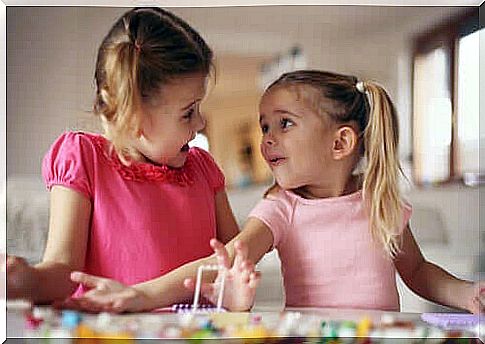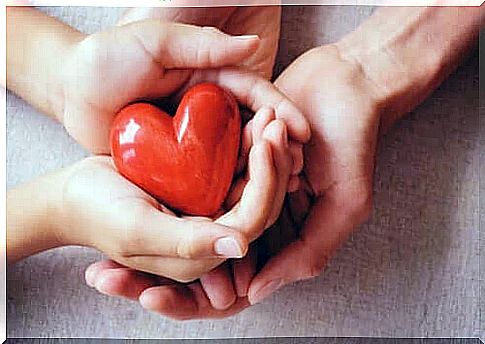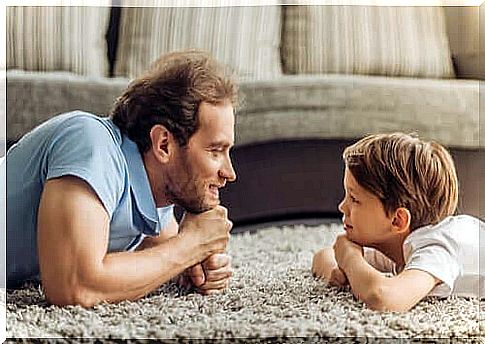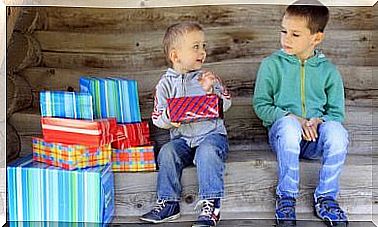The Development Of Empathy In Childhood

Before explaining the development of empathy in childhood, let’s take a look at the term itself. The origin of the concept of ’empathy’ stems from what the Scottish Enlightenment called ‘sympathy’. David Hume, in his thesis on human nature, and Adam Smith described it as a natural means of communication.
This definition is the foundation of neuroscience, developmental psychology, and social psychology. The development of empathy in childhood reveals very interesting facts about some evolutionary aspects of our species.
There is one idea that stands out: our socialization is not the result of empathy, at least not originally. Evolutionary biology tells us that altruistic behavior arose before we acquired this potential.
Some species that lack empathy exhibit such behavior. This is the case with social insects, such as bees. They die shortly after stabbing a target because they sacrifice themselves to protect their community. So the connection between empathy and altruism is not simple.
The approach according to developmental psychology

The work of Lipps (1903) (link in English) focused on the difference between the terms ‘sympathy’ and ’empathy’. Researchers in developmental psychology defined empathy as a multidimensional concept that takes into account the cognitive component.
Thus, it includes the recognition and understanding of other people’s emotions and the emotional component, which is related to the sharing of affection or an indirect response.
Cognitive models of empathy development
Since the 1990s, empathy has been studied from the perspective of emotional intelligence. This is where the Mayer and Salovey (1997) model stands out. Empathy is considered to be the perception and understanding of the emotions of others.
Another relevant model is the Bar-On model of emotional-social intelligence (1997, 2000). This model claims that empathy is part of a factor we refer to as interpersonal skills. That is, the ability to be aware of and understand other people’s emotions, feelings, and ideas.
These two models are not as integral as the models proposed by developmental psychology. Actually, they focus more on the cognitive component.
Recently, Batson and his collaborators identified a distinction between perspective and empathy. Gaining perspective appears to be the precursor of specific empathic responses (Batson et al., 1992).
Hoffman’s model of the development of empathy in childhood
Hoffman, a leading theorist on the development of empathy in childhood, recognizes two dimensions in the study of empathy:
- The recognition of the internal state of other people.
- The indirect loving response.
Hoffman’s model explains how empathy starts and how it develops in children. In fact, he argues that the central idea is the integration of affection and cognition beyond an approach to information processing.
He argues that empathy develops in the same way as the stages of social-cognitive development. That process begins with an empathetic global feeling in which a child does not clearly distinguish between itself and others. As a result, they are confused about the source of the feelings.
From here it goes through different phases to the most advanced phase which combines what one has achieved in previous phases. In the more advanced stages, a person can empathize with others. Mainly by knowing that there are physical entities other than themselves and that others have internal states independent of them.
A mature level of empathy can affect a person more by the vital circumstances of others than by an immediate situation. According to Hoffman, there must be a parallelism between feelings and affection with thoughts, moral principles and behavioral tendencies.
Stages of Empathy Development in Childhood
According to Hoffman, the development of empathy from early childhood consists of four stages, we discuss them below.
The first stage of empathy development in childhood (global)
This happens during the first year of a person’s life. Here a child still does not see others as other than himself. As a result, they mistake the pain they perceive in others as their own, just as if it were happening to them. For example, a baby who sees his mother crying will probably have to wipe his own tears.
Another example: an 11-month-old girl sees another girl fall and starts to cry. She stares at the victim for a moment, sticks her thumb in her mouth and hides her face in her mother’s lap. She behaves as it would have been the likely reaction if she had fallen herself.
The second stage (egocentrism)

This phase corresponds to the second year of a person’s life. Here the child is aware that others also experience unpleasant situations. However, they assume that the internal moods of others are the same as they experience themselves.
For example, a 13-month-old boy who sees a sad adult may offer him his favorite doll. Another example is when a child brings his mother to comfort another child of the same age who is crying.
The third stage (other people’s feelings)
This phase lasts from the second to the third year of life. Then children are aware that the feelings they experience are different from those of others. Yet they can respond to it in a selfless way.
During this time, children can already understand that the intentions and needs of others are different from their own. Therefore, they understand that someone else’s emotions can also differ from their own. In this way they can offer comfort to others.
Fourth stage (other living conditions)
This last stage is the last period of childhood. In it, the feelings of others are seen not only as reactions of a moment, but also as expressions of their general life experience. That is, they respond differently to transient and chronic pain because they consider the general condition of others.









